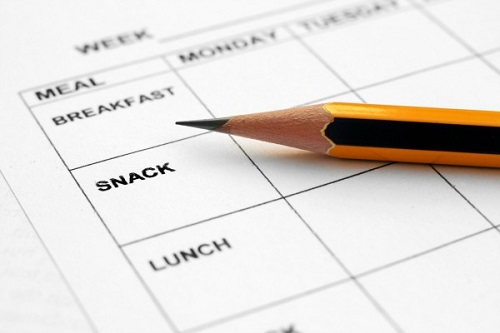You eat in a variety of places - your home, work, restaurants, maybe even your car. For some of these places, you have more control over what choices are available than others. Since high-calorie foods are everywhere, it's important to take the time to plan ahead to make sure you have healthy options available.
Scientific studies show that people get full by the amount they eat as opposed to how many calories they intake. Adding fiber rich, low-calorie foods to meals help the body feel full without adding extra calories.
Focus on foods that support a healthy diet such as fresh fruits, fresh vegetables and calcium rich foods. Fresh fruits are great for people craving a healthy diet but not willing to give up sweets. Fruits are rich in nutrients and vitamins but still taste delicious. Canned and frozen fruits can also make a great snack when fresh fruits are not readily available. Fruits are also much lower in calories than other sweets.
MEAL PLANNING PRACTICE: MAP OUT YOUR WEEKLY EATS
1. Grab a pen and paper. Write the days of the week on the left side of the page and the meals you want to plan across the top.
2. Sketch out your weekly eats. Vague descriptions like quick dinner, leftovers, or packable lunch are fine for now. Don’t forget to plan for leftovers and make note of special dietary restrictions here as well.
3. Tally them up. Note how many meals you’ll need, grouping together similar ones. For example: 2 quick dinners, 3 packable lunch
Fresh vegetables are also rich in important nutrients and vitamins important to maintaining a healthy weight. Vegetables are low in calories and very versatile. Grilled, steamed and sautéed vegetables can make a satisfying, healthy meal.
Calcium rich foods are important to maintaining a healthy weight. Consuming low-fat and fat-free dairy products are a great substitute for fatty dairy products and still build calcium for strong bones.
Planning meals is part of eating healthy. Planning meals, as opposed to just grabbing meals on the go, promotes healthy choices. Meal planning gives approximate calories in meals and helps balance food intake throughout the day. Planning meals also gives the cook the opportunity to alter and manipulate meals to support a low-fat, low-calorie diet.
Meals on the Go
For the places where you might grab a snack or have a meal on the go (such as the car or at your desk), make sure you have nutritious snacks available or at home that you can take with you. For example:
"Grab-and-go" fruits: apples, oranges, bananas, canned fruit without added sugars, and raisins
Washed and chopped fresh vegetables: celery, carrots, and cucumbers
Low-fat and fat-free milk products: yogurt without added sugars, milk, and low-fat cheeses
Whole-grain crackers and breads
Protein choices such as low-fat deli turkey slices or almonds and other nuts and seeds
Some foods have negative calories.
Sounds like a dream food, doesn't it? There is information available to us about these types of foods but there is not one scrap of factual scientific proof that is strictly speaking, of such things. While some foods containing negative kilojoules have been labeled, such as apples, cabbage, celery, carrots and green beans, just to name a few, most contain little or no real nutritional value either.
Based largely on the concept that if these types of foods once consumed will burn more calories during the digestion process it would stand to reason that many dieters believing that by regularly eating such foods, including the ones of little nutritional value and because of the 'negative kilojoules' concept attached to them, believe that they can consume great quantities. This may lead to a problem though because it encourages overeating which as we know is unhealthy and also could be a cause of malnutrition if this dieting approach was sustained over a period of time. This is because you are not getting a broad spectrum of the necessary vitamins and minerals our bodies need to live
There are only two genuine negative Kilojoule substances, the first being water which as we know doesn't contain any kilojoules at all and the second is cellulose! So keep dreaming!






0 Comment to "planning meals for weight loss"
Post a Comment